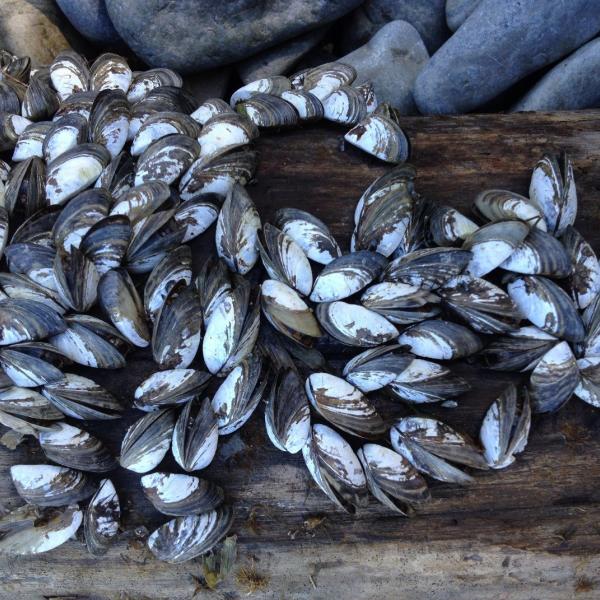
As Vermont lakes continue to warm and thaw, it won’t be too long before throngs of boaters, anglers, swimmers, and divers being to appear on some of Vermont’s most beautiful natural resources. There are endless opportunities to enjoy the State’s waterbodies during the summer months and many of us will spend countless hours on or near the water as temperatures rise. However, for the invasive species that reside in some of our waters, this is also a time for growth and reproduction. This also means that the risk of spreading these invasive pests is highest during the summer and that is especially true of one of North America’s most notorious aquatic invasive species: the zebra mussel.
Remarkably, the threat of zebra mussels is often overlooked in Vermont. Eurasian watermilfoil is the poster child for aquatic invasives in the Green Mountain State and many in the Champlain basin are well aware of the capacity of water chestnut to completely choke out large expanses of water. In the last couple years, you may have heard reports of new invasives to the State, including Asian clams, starry stonewort, and spiny waterflea. Sure, zebra mussels have been in Lake Champlain for over two decades and have been documented in Lake Bomoseen for almost as long, so it’s easy to forget about them considering more recent invasions of other species. And yes, there hasn’t been a newly confirmed population in Vermont in 18 years, which can surely be attributed in part to statewide education efforts on the importance of draining and drying vessels and other equipment. But zebra mussels are no less of a threat to other Vermont lakes now than they were years ago, and efforts to stop their spread are just as important now as they were in the 90s.
Zebra mussels are small (quarter-sized, at most), freshwater mollusks native to the Caspian and Black Seas. When introduced to a system, they can quickly reproduce and infest an area, reaching 700,000 individuals per square meter in a short time period. Reproduction occurs when water temperatures are above 50˚ F, which constitutes roughly half of the year in Vermont. During this time, adult mussels are laying eggs that quickly hatch into free-floating juveniles, called veligers. These veligers, undetectable to the naked eye, eventually settle onto hard or semi-soft surfaces, where they then grow into adults and begin reproducing themselves. During this free-floating stage, the risk of unknowingly transporting this invasive pest is highest, as dozens can exist in even a few drops of water from a contaminated water body. Unlike all other freshwater mollusks, these mussels attach to surfaces using string-like structures called byssal threads. Many of the problems caused by these creatures are due to that ability bind themselves to pipes, rocks, plants, other creatures, and almost anything else found on a lake bottom other than silt and mud.
Ask any freshwater aquatic resource manager west of the Mississippi River which invasive species they most fear and Dreissenid mussels (zebra mussels and their close cousin, quagga mussels) will be the universal answer. You will probably get the same response if you ask anyone that has been recently swimming or diving in Lake Champlain. The ability of these small mussels to quickly colonize every square inch of hard substrate in a waterbody can wreak havoc on infrastructure, as well as anyone unlucky enough to step on their shells in bare feet. They can clog intake pipes so quickly that some western states now must spend millions of dollars annually just to keep those pipes clear enough to transport drinking water from large reservoirs to their populace. From an ecological perspective, research has demonstrated the disastrous effects that they can have on fisheries and native species. Each adult mussel has the potential to filter over a liter of water per day, removing the microscopic organisms that form the base of all aquatic food chains. This may not seem like a lot, but considering the high densities that these animals can attain, it’s quite substantial. A significant amount of energy ends up sequestered on the lake bottom, and therefore unavailable to other benthic creatures and to desirable sportfish.
There are certain environmental limitations that may restrict the proliferation of Dreissenid mussels in certain lakes, including nutrient limitations and lack of available substrate. There are probably lakes in Vermont that are more likely to support a problematic population than others, but all are at risk to some degree. So, as the sun begins to shine and we spend our days kayaking through wetlands or hitting our favorite bass-fishing hole, we should be taking precautions so that we are not spreading aquatic invasives. This is especially true if your favorite haunts are on Lake Champlain. Make sure that all gear is drained, clean, and dry before entering and upon leaving a waterbody, and let gear dry as long as possible in the sun before moving it from one waterbody to another. Remember, it only takes a few drops of water to sustain viable juvenile mussels, so make sure to dry everything that comes in contact with water. Let’s keep zebra mussels from spreading to another Vermont waterbody for another 18 years (and beyond)!
By Josh Mulhollem, VTDEC